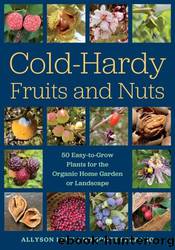Cold-Hardy Fruits and Nuts by Allyson Levy

Author:Allyson Levy [Levy, Allyson & Serrano, Scott]
Language: eng
Format: epub
Published: 0101-01-01T00:00:00+00:00
Heartnut foliage.
Growth Difficulty Rating: 1. Heartnut trees are easy to grow, with only minor pest problems.
Taste Profile and Uses: The oval or heart-shaped nuts are covered in a green husk and hang on long racemes in bunches of two to twenty, which mature in late summer. Under the shuck (husk), the smooth, light brown outer shell is ovate and slightly flattened with one pointed tip. When cracking open the cultivated variety, 1- to 1½-inch (2.5â3.8 cm) shells, it looks like a flattened heart-shape outline, with a slight ridge dividing the shells front and back. The nuts are said to be thin-shelled compared with the thicker-shelled black walnut (see âBlack Walnutâ chapter) and are easier to crack. The heart-shaped kernels are plump and light gold in color, although nuts that have a uniform pale gray or beige tone are also fine to eat. The flavor has a mild nutty taste with no bitterness and is often compared to a butternut. The flavor of the shelled nuts will actually improve in storage at room temperature and peaks between five and eight years after harvest. Beyond ten years at room temperature, heartnuts may become slightly stale, but they are still good enough to use.9
Plant Description: Heartnut is a deciduous tree growing up to 60 feet (18.3 m) tall, but more commonly grows to 30 feet (9.1 m), and the trees tend to grow as wide as they are high. The leaves, which are composed of eleven to seventeen pinnately compound leaflets arranged along the opposite sides of the stem, can reach up to 3 feet (91 cm) in length, giving the trees a tropical appearance. Each leaflet is light green and slightly hairy, and grows between 2 and 6 inches (5.1â15.2 cm) long and up to 2 inches (5.1 cm) wide.
The trees also have a good reputation for yielding crops at a younger age than many other members of the walnut family. Seedling trees often bear crops when they are five to seven years of age, with grafted trees often yielding crops in one to three years.10 In our gardens the two heartnut trees began to flower after five years and produced immature nuts after seven years.
Flowers: The heartnut is monoecious producing both male and female flowers on the same tree. The male flowers are the yellow-green catkins, which typically grow 6 to 10 inches (15.24â25.4 cm) long. The female flowers are produced with the flush of the current seasonâs leaf growth and are shaped like small pea-sized ovals, topped with scarlet red pistils for receiving the pollen. Pollination is carried out by the wind. The trees produce large quantities of flowers in spring at the same time that new leaves appear.
Pollination Requirements: Heartnut trees are only partially self-fertile and a single tree can bear small crops, but two or more trees planted together will produce a lot more of the nuts. The male and female flowers on individual trees open at different times and so planting two trees together will help cross-pollination.
Download
This site does not store any files on its server. We only index and link to content provided by other sites. Please contact the content providers to delete copyright contents if any and email us, we'll remove relevant links or contents immediately.
Turbulence by E. J. Noyes(7058)
The Thirst by Nesbo Jo(5793)
Gerald's Game by Stephen King(3927)
Be in a Treehouse by Pete Nelson(3234)
Marijuana Grower's Handbook by Ed Rosenthal(3126)
The Sprouting Book by Ann Wigmore(3056)
The Red Files by Lee Winter(2923)
The Remains of the Day by Kazuo Ishiguro(2627)
Sharp Objects: A Novel by Gillian Flynn(2451)
Christian (The Protectors Book 1) by L. Ann Marie(2396)
Organic Mushroom Farming and Mycoremediation by Tradd Cotter(2314)
The Culinary Herbal by Susan Belsinger(2063)
Stone Building by Kevin Gardner(1998)
The Starter Garden Handbook by Alice Mary Alvrez(1930)
Lilac Girls by Martha Hall Kelly(1883)
The Unlikely Pilgrimage of Harold Fry by Rachel Joyce(1838)
The Lean Farm Guide to Growing Vegetables: More In-Depth Lean Techniques for Efficient Organic Production by Ben Hartman(1789)
Urban Farming by Thomas Fox(1752)
Backyard Woodland by Josh VanBrakle(1591)
